|
|
|
| Anterior Loop Connector Fixed Partial Denture For Maintenance Of Diastema. A Clinical Report |
Himanshu Kapoor 1 , Archana Nagpal 2 , Rupandeep Kaur Samra 3 , Rajeev Gupta 4
1 Senior Lecturer , Dept. Of Prosthodontics - Himachal Dental College
2 H.O.D , Dept. Of Prosthodontics - Himachal Dental College
3 Reader , Dept. Of Prosthodontics - Himachal Dental College
4 Professor , Dept. Of Prosthodontics - Himachal Dental College
|
| Address For Correspondence |
Dr. Archana Nagpal
H.O.D., Department Of Prosthodontics
Himachal Dental College, Sundernagar |
| Abstract |
| Replacement of maxillary anterior teeth in patients with natural diastema present problems as the increased mesio-distal space makes it difficult to give normal fixed prosthesis with rigid connector. Uniform diastema present before extraction may result in excessive width of the pontic space. Wider pontics can be very unesthetic to look at in the esthetic zone. This is a challenging clinical situation for the prosthodontist and leaves him in a dilemma whether to close the space or to maintain it in the final fixed prosthesis to simulate the natural tooth appearance. If an implant-supported prosthesis is not possible or not selected as a treatment option, loop connector fixed partial denture may be the best solution to maintain the diastema and esthetics. Two case reports have been presented here describing the procedure of replacing missing central and lateral incisor with loop connector fixed partial prosthesis while maintaining diastema. |
|
| Keywords |
| Loop connector, diastema, fixed partial denture, esthetics. |
|
| Full Text |
Introduction
Connectors are the components of the fixed partial denture that join the retainers and the pontics together. Connectors are of two types: rigid and non rigid. Loop connectors are non-rigid connectors which are required when an existing diastema is to be maintained in a planned fixed prosthesis[1]. Drifting of teeth into the edentulous area may reduce the available pontic space; whereas a diastema existing before extraction may result in excessive mesio-distal width in the pontic space[3]. In these situations, the simplest approach to maintain existing diastema is using loop connector. These connectors consist of a loop on the lingual aspect of prosthesis that connects the adjacent retainer and/or pontics. This article presents two case reports where the missing anterior teeth were replaced with a FPD incorporating loop connector.
Case Report 1
A 24-year-old male patient reported to the Department of Prosthodontics, with a chief complaint of missing upper front teeth and a fractured tooth (Fig.1). There was history of trauma seven months ago. His prime concern was replacement of the missing front teeth as he felt very conscious of his looks. Patient also revealed that he had spacing present among his natural teeth before the accident. On oral examination,11 and 12 were missing and the edentulous space was larger than the required for replacement of 11and 12 . 21 had Ellis’ class II fracture. A tooth implant was a viable alternative as it would allow a restoration maintaining the diastema, but the patient was not willing for implant surgery and wanted an immediate fixed alternative for the missing teeth. Alternate treatment option was loop connector fixed partial denture to restore the missing teeth with 11and 12 as a pontic and 13 and 21 as an abutments.
 | Fig. 1 Pre-operative View
 |
Radiographs of abutment teeth 21 and 13 were made and on endodontic evalution they were found to be vital, so a composite build up (3M ESPE shade A2 Valux Plus) was done on left central incisor. Two sets of maxillary and mandibular impressions were obtained for making the diagnostic casts and the mock-up of final restoration. Two diagnostic mock ups were made. In first mock up, no diastema was kept between adjacent teeth. In second mock up, a fixed partial denture was designed with a loop connector to make the replacement esthetic and in accordance with overall alignment of his other teeth. Both the wax -ups were shown to the patient and the second wax up was approved by him .Tooth preparation of the abutment teeth i.e . 21 and 13 was done to receive porcelain- fused-to-metal crowns with sub-gingival finish line (Fig.2). Retraction procedure was carried out (Ultrapak 01 ultra-dent) and the impression was made by putty wash two-step impression technique (Aquasil, Dentsply DeTrey GmbH Pvt. Ltd., Germany soft putty/light body set) with a rim lock impression tray. Provisional restoration was fabricated using tooth colored acrylic resin and was cemented with zinc oxide eugenol cement (Kalzinol, Dentsply). Loop connector was designed and three loops were given for support and retention (Fig.3). The dimension of the connector was 2mm with a relief provided by using 0.2mm relief wax. Wax patterns were cast and the metal copings were finished. After verifying the fit of the metal copings in patient’s mouth, ceramic build up was done. The finished prosthesis was tried in patients mouth and once he was satisfied, it was cemented using glass- ionomer luting cement ( Ketac 3M ESPE) (Fig. 4). Patient was now confident of his smile (Fig. 5).
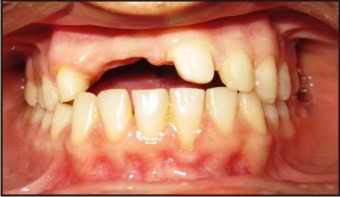 | Fig. 2 Prepared Tooth For Loop Connector
 |
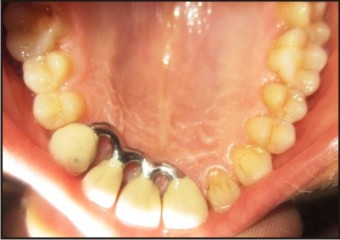 | Fig. 3 Palatal View Of Loop Connector
 |
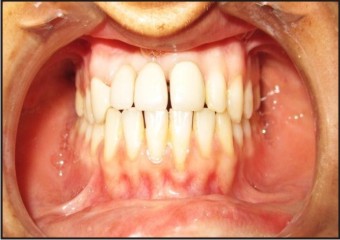 | Fig. 4 Post-operative View
 |
 | Fig. 5 Post-operative View
 |
Case Report 2
A 36-year-old female patient reported to Department of Prosthodontics, with a chief complaint of missing teeth in the upper front region. Her prime concern was esthetics. On oral examination, it was found that 21 was missing and edentulous space was large enough than that required for replacement of the central incisor 21 (Fig. 6). A single tooth implant could have been planned in this case but patient was not willing for implant surgery due to economical reasons. She wanted some other fixed alternative for the missing central incisor. A loop connector fixed partial denture was thus planned to replace the missing central incisor in which 11and 22 were used as a abutments. 11and 21 were prepared to receive porcelain fused to metal crown. (Fig.7) Only labial facing of ceramic was done because of less available space due to deep bite. The same procedure for the fabrication of the loop connector was carried out as mentioned for the previous case. The finished and polished restoration was seated in the patients’ mouth. (Fig. 8 & 9) Both the patients were instructed to maintain oral hygiene.
 | Fig. 6 Pre- Operative View
 |
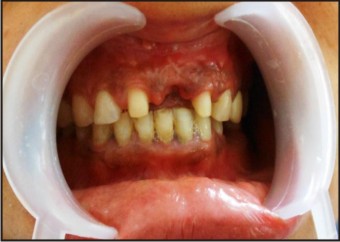 | Fig. 7 Prepared Tooth For Loop Connector
 |
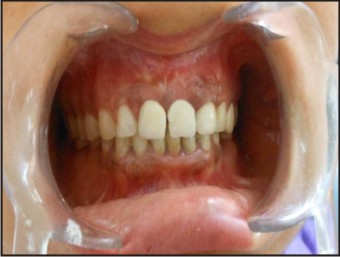 | Fig. 8 Post- Operative View
 |
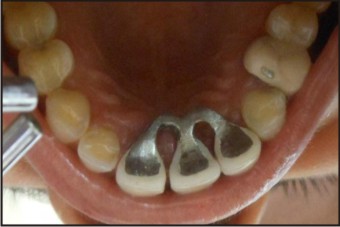 | Fig. 9 Palatal View Of Loop Connector
 |
Discussion
Loop connectors are required when an existing diastema is to be maintained in a planned fixed prosthesis[1]. The presence of the anterior extensive diastema is a difficult esthetic problem to resolve with conventional fixed partial dentures. This spacing between the teeth can be due to genetic causes, high frenum attachment, presence of a mesiodens,, retained teeth or proclined mandibular teeth[5]. Maximum esthetic results may be obtained if the natural anatomic forms of the teeth are protected and the diastema is maintained with minimal over contouring of the adjacent teeth. Although implants and removable partial denture are also viable options but a loop connector FPD can also be used to solve the problem of excessive mesio-distal width of pontic space. Meticulous design is important to ensure that plaque control is not impeded. The palatal connector in fixed partial denture is a type of loop connector[2]. The connector here is a long, thin and resilient bar, closely adapted to the palate so that it is partly supported by soft tissue. The long palatal connector in fixed partial denture may deform, if thin, and produce coronal displacement of the pontic[2]. It is important that it should not interfere with speech as it will then be poorly tolerated. The size, shape and position of the connector is vital for the prosthesis, as it prevents its distortion and fracture[3]. In a loop connector fixed partial denture, the connector consists of a loop on the lingual aspect of the prosthesis[1]. Metal used for fabrication for loop connector is cobalt- chrome metal alloy and not nickel- chrome as it can cause allergic reactions[4]. The loop may be cast from sprue wax that is circular in cross section or shaped from platinum-gold-pallaium (Pt-Au-Pd) alloy wire. The connectors should not be very thick and should have an intimate contact with the underlying mucosa; otherwise, there are chances that patient may develop an annoying habit of pushing tip of the tongue into the gap between the loop and the mucosa. In the above two cases, loop connector fixed prosthesis addressed the problem of excessive mesio-distal width pontic space and it is also easy to clean and maintain[6]. Spring cantilever loop connector can also be used as other treatment option where we have to maintain the space between the teeth
Conclusion
Different treatment options i.e. dental implants, resin bonded FPDs, conventional fixed partial denture etc are available to replace the missing front teeth. Presence of excessive spacing amongst the anterior teeth makes the esthetic replacement a great challenge to the dentist specially if fixed partial denture is planned Use of innovative techniques to achieve esthetic results in FPD treatment procedures makes loop connectors a suitable and a viable treatment option especially in case of excessive mesio-distal space in the region of a pontic. Loop connectors have several advantages when it comes to the esthetic appearance, but the patient might object to the projecting minor connector in the palatal region and it might be a potential food trap for the patient. If the patient can be motivated to get adapted to the loop connector, it can be an excellent treatment option in cases where excessive space is present in the esthetic zone.
References
1. Rosenstiel S, Land M, Fujimoto J.Connectors for partial fixed dental Prosthesis Contemporary fixed Prosthodontics 4th edition. New Delhi, Elsevier,2007. p. 843-69.
2. Shillingburg HT Jr, Hobo S, Whitsett LD, Jacobi R, Brackett SE. Fundamentals of fixed prosthodontics. 3rd edn Passi; India; 1997. p. 95-100.
3. Kamalakanth S, Arbaz S. Anterior loop connector fixed partial denture: A simple solution to a complex prosthodontic dilemma. Jo Indian Prosthodontic Soc 2008; 8:162.
4. Breeding L, Dixon D. Transfer of gingival contours to a master cast. J Prosthet Dent1996;75(3):341-3
5. Bello A, Jarvis RH. A review of esthetic alternatives for the restoration of anterior teeth. J Prosthet Dent1997;78: 437-40.
6. Dange SP, Khalikar AN, K. Shiv. Non-Rigid connectors in fixed dental prosthesis- A Case Report. JIDA 2008;2: 356-8.
|
|
|
|
|
|
|